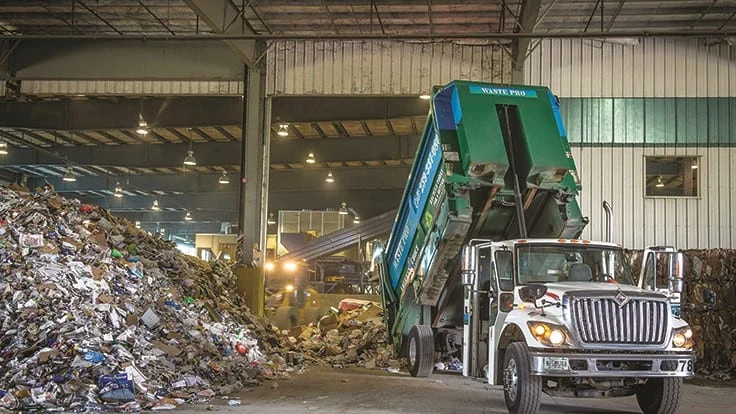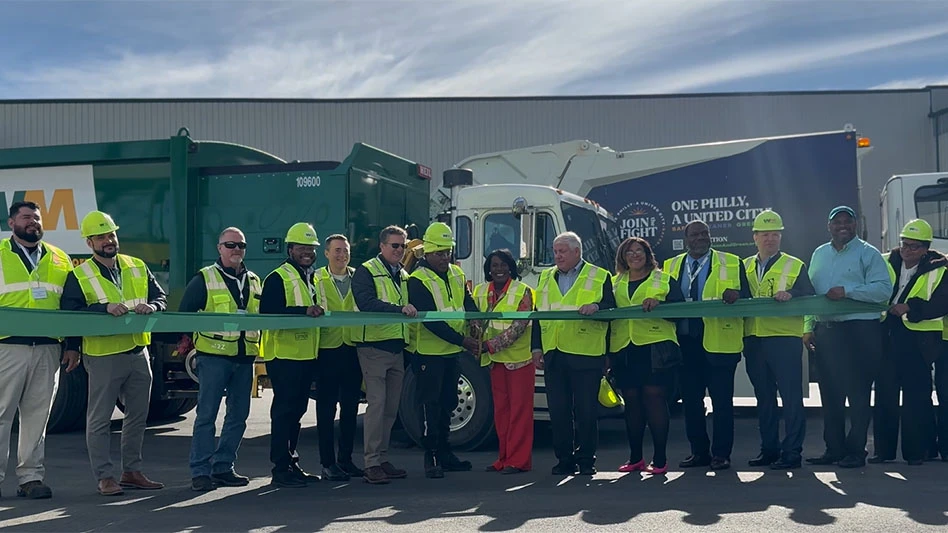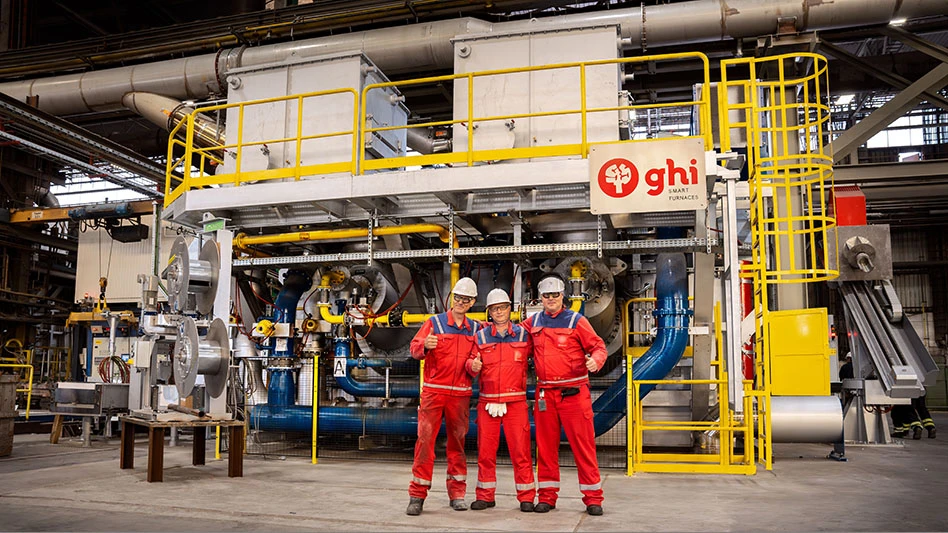
Photo from Recycling Today archives
The Recycling Leadership Council (RLC) hosted an online press conference Feb. 4 to introduce its “Blueprint for America’s Recycling System,” which outlines areas where the federal government can assist with strengthening the recycling system in the United States. U.S. policymakers also joined the RLC on the call.
The Consumer Brands Association’s (CBA’s) RLC, which was formed in early 2020, includes that association as well as the American Cleaning Institute; PMMI, The Association for Packaging and Processing Technologies; the Household & Commercial Products Association; the nonprofit Ocean Conservancy; the Recycling Partnership; and Closed Loop Partners, among others.
Geoff Freeman, president and CEO of the Arlington, Virginia-based CBA, said in the press conference that the RLC and the suggestions it offers in its blueprint illustrate “phenomenal collaboration between wide-ranging interests” and “how the federal government can be a positive force in fixing recycling in the U.S.”
He added, “We all have responsibility” for the success of the U.S. recycling system but “can’t fix what ails recycling in America without help from the federal level.”
The RLC’s blueprint focuses on three areas where it says the federal government can make a meaningful difference in recycling in America:
- The federal government can create clear data collection and reporting requirements to further understand the problem and inform the creation of a system that works. Standardized, quantifiable data are lacking across the country, according to the report, which calls for the federal government to establish a definitive baseline of performance through an Environmental Protection Agency (EPA) data collection effort; identify opportunities for investment, improvement and innovation through an EPA-conducted needs assessment; and identify sources of mismanaged waste globally and domestically.
- The federal government can develop national standards and definitions across the nation’s nearly 10,000 recycling systems, providing clear guidance to states and municipalities and taking the confusion out of the process for consumers and packaging producers. The report calls for the federal government to establish national goals and minimum performance standards for recycling programs, recognize top-performing material recovery facilities (MRFs) and harmonize recycling across the federal government by 2030. Through standardization and harmonization, more and different types of materials can be collected, processed and sold for value-added products or packaging, the RLC says.
- The federal government can support states with targeted infrastructure investments, tax credits and grants. Funding must be dedicated to the systems themselves, such as enhancing recycling infrastructure or educating consumers, according to the report. The federal government also can support economic opportunity through end-market development by increasing federal agency purchasing targets for recycled-content products and providing R&D grants to universities and research institutions, according to the report.
Meghan Stasz, vice president of packaging and sustainability at the CBA, described the federal government as a “critical piece of holistic puzzle," saying, “Federal action and leadership can help accelerate solutions” for recycling in the U.S.
“Attempting to address these issues city by city or county by county won’t get us fundamental change,” she added.
Stasz said fixing recycling in the U.S. is a catalyst for ending the linear economy in this country.
While the exact cost of the necessary improvements in U.S. recycling infrastructure is not yet known, Dylan de Thomas, vice president of external affairs at The Recycling Partnership, Falls Church, Virginia, said that organization will release a capital needs study later this year, though he estimated the need to be in the billions of dollars.
“The cost of inaction is greater than the investments we need,” said Kate Krebs, director of industry affairs at Closed Loop Partners, which is based in New York City.
Though not mentioned in the report, de Thomas said he believed producers should help fund recycling in the U.S. through the extended producer responsibility (EPR) model. “Community budgets have always been tight,” he said. “We’re at a critical point in the aging U.S. recycling system right now. We cannot accept the status quo. We need a federal funding model to level the system up.”
“No silver bullet is going to fix all of this,” added Scott DeFife, president of the Glass Packaging Institute, Arlington. “Even EPR is only a way to finance the stuff that is to come.”
The RLC is calling on Congress to write and pass comprehensive recycling legislation this year and says it will deliver copies of the “Blueprint for America’s Recycling System” to members of Congress and the Biden administration. The group says addressing recycling at the federal level has bipartisan support. The RLC says it looks forward to working with the leadership of the Senate Recycling Caucus, Sens. Tom Carper (D-DE) and John Boozman (R-AR), as well as Save Our Seas legislation sponsors Sens. Sheldon Whitehouse (D-RI) and Dan Sullivan (R-AK); and Congresswoman Haley Stevens (D-MI-11), who launched the Congressional Plastic Solutions Task Force.
In a news release regarding the blueprint, Carper says, “As a life-long recycling advocate, I’ve always believed that recycling is a win-win solution: It helps grow our economy, and it’s good for the environment. But today, America’s recycling system is not working, especially with respect to plastics. Recycling in our country is in dire need of new policies and solutions. This Congress, I believe that we have an opportunity to work to develop bipartisan, commonsense recycling policies that are good for local communities and our planet.”
“We have an opportunity to improve our nation’s recycling infrastructure and better leverage the economic and environmental benefits of recycling,” Boozman says. “With the help of the Recycling Leadership Council, we continue to examine the best ways to address the challenges facing the recycling industry. I look forward to working together to implement long-term solutions to make recycling easier to help improve our environment.”
At least one environmental organization has voiced its disappointment in the report.
John Hocevar, Greenpeace USA Oceans campaign director, released a statement that reads in part: “It should come as no surprise that the association representing the world’s largest plastic polluters wants to double down on individual responsibility and recycling efforts to solve the pollution crisis. If the Consumer Brands Association wants to be seen as constructive and relevant in discussions about waste, plastic packaging and recycling, it will need to do better than rehashing decades-old ideas that have repeatedly failed. We have moved well past the point where it is useful to simply push for additional studies and public investment to clean up industry’s mess.
“Real solutions start with an honest assessment of the problem, which goes well beyond waste and will require far more than recycling to solve. It is time to abandon throwaway packaging, especially plastics, and incentivize systems of reuse. If industry will not stop using single-use plastic on its own, then government will need to step in. Today’s blueprint is just another ‘call to action’ from an industry front group that fails to acknowledge this fundamental reality.”
Latest from Recycling Today
- ReElement, Posco partner to develop rare earth, magnet supply chain
- Comau to take part in EU’s Reinforce project
- Sustainable packaging: How do we get there?
- ReMA accepts Lifetime Achievement nominations
- ExxonMobil will add to chemical recycling capacity
- ESAB unveils new cutting torch models
- Celsa UK assets sold to Czech investment fund
- EPA releases ‘National Strategy to Prevent Plastic Pollution’





